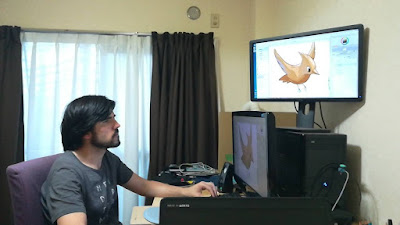The event took place at Tokyo Big Sight and the entrance fee, which included a catalogue book, was 1000 yen. For some reason, the entrance was free after around 13:00.
One of the main attractions was the live drawing event by Kim Jung Gi (@KimJungGiUS, @kimjunggi_jp). This was actually the second time I watched him drawing live, the first time being at Nakano Broadway. During his performance, Kim usually answers various questions from the audience and the commentators. It must be hard for him to concentrate!. Then, Risa Kageyama translates his words into Japanese.
This time the canvas was a bit hard to see, so the process was projected on a big screen. The way that Kim Jung Gi draws is mind-blowing. It looks like he has the whole composition inside his mind and he can start drawing from anywhere without any reference lines.
This was the final result. Kim is not really that good at drawing cute anime-like girls. His style is closer to the kind of artists that used to publish on the Heavy Metal magazine. I guess that was a character related to the sponsor of the event, the Fun's Project Channel, an excellent website with educational contents for artists and creators. There are more pictures and a video on Kim's Twitter account, make sure you check them out.
Apart from Kim, other notable artists such as Sean Phillips or Duncan Fegredo attended the convention. I also took the opportunity to walk by the booths in Comitia 126 and discover great artists such as:
- @pochi1989
- krenzartwork
- hunwaritoast
- kaitan0908
- dieselzombie
- ue_tateri
- naffy
- JohnHathway
- @taiwan_shurara
- haikeisouko (manga and anime backgrounds)
- fanza (digital adult manga shop)
- kindle indie mangas (lots of amateur manga for free!).
































